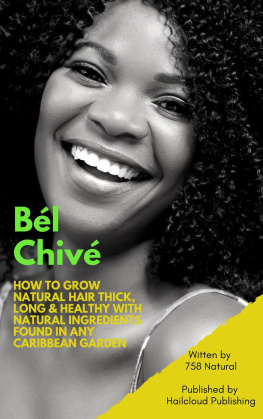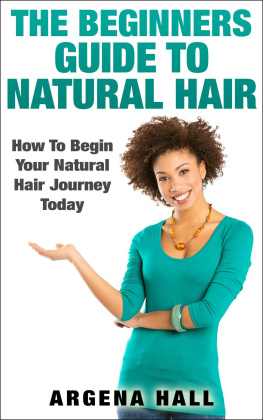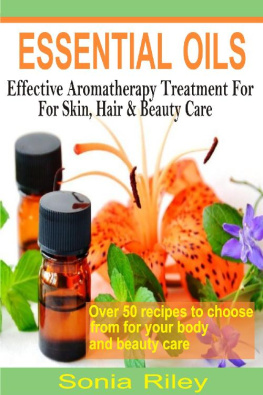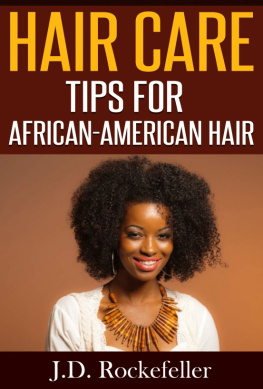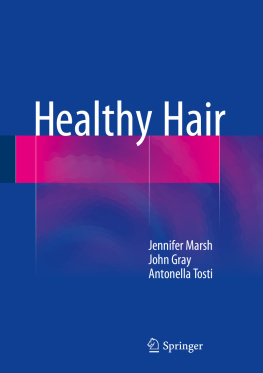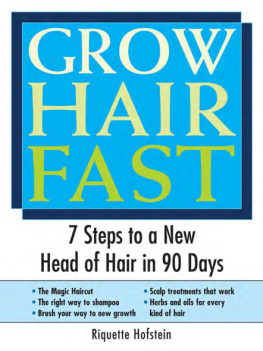Vonzabuesnig - Aroma Hair: Aromatherapy Formulas For Healthy Hair
Here you can read online Vonzabuesnig - Aroma Hair: Aromatherapy Formulas For Healthy Hair full text of the book (entire story) in english for free. Download pdf and epub, get meaning, cover and reviews about this ebook. year: 2011, publisher: Lulu.com, genre: Home and family. Description of the work, (preface) as well as reviews are available. Best literature library LitArk.com created for fans of good reading and offers a wide selection of genres:
Romance novel
Science fiction
Adventure
Detective
Science
History
Home and family
Prose
Art
Politics
Computer
Non-fiction
Religion
Business
Children
Humor
Choose a favorite category and find really read worthwhile books. Enjoy immersion in the world of imagination, feel the emotions of the characters or learn something new for yourself, make an fascinating discovery.
- Book:Aroma Hair: Aromatherapy Formulas For Healthy Hair
- Author:
- Publisher:Lulu.com
- Genre:
- Year:2011
- Rating:5 / 5
- Favourites:Add to favourites
- Your mark:
- 100
- 1
- 2
- 3
- 4
- 5
Aroma Hair: Aromatherapy Formulas For Healthy Hair: summary, description and annotation
We offer to read an annotation, description, summary or preface (depends on what the author of the book "Aroma Hair: Aromatherapy Formulas For Healthy Hair" wrote himself). If you haven't found the necessary information about the book — write in the comments, we will try to find it.
Aroma Hair: Aromatherapy Formulas For Healthy Hair — read online for free the complete book (whole text) full work
Below is the text of the book, divided by pages. System saving the place of the last page read, allows you to conveniently read the book "Aroma Hair: Aromatherapy Formulas For Healthy Hair" online for free, without having to search again every time where you left off. Put a bookmark, and you can go to the page where you finished reading at any time.
Font size:
Interval:
Bookmark:

Copyright, Disclaimer and Legal Notice
Aroma Hair
The information contained in this book is not intended or implied to be a substitute for professional medical advice. It is the readers responsibility to use the information in this book in a safe and responsible way and to obtain professional advice when necessary. Although every reasonable attempt has been made to achieve accuracy, the author assumes no responsibility for errors and omissions. As more advanced scientific research continues, safety guidelines may change. It is the readers responsibility to keep updated on safety information when using essential oils.
Copyright 2007 by Melanie Vonzabuesnig
All rights reserved. No part of this book may be
reproduced or transmitted in any form or by any means
without written permission of the author.
eISBN: 978-1-25720-303-1
Id like to express very special thanks and appreciation for the cover artwork designed by:
Holly Ryno and Brendan Vonzabuesnig
and
Sandy Lee Jones
www.lovecreateinspire.com
for her graphic work on cover
It wasnt all that long ago when most of our medicines, cosmetics and perfumes were generously provided by nature. Seeds, berries, nuts, leaves and flowers were gathered and prepared to make precious ointments, oils and teas for physical and mental health, and for beauty!
These same botanical materials are the foundation of aromatherapy. Aromatic oils, called essential oils are distilled from various parts of plants to provide us with a gentle but powerful healing agent that is as delightful to use as it is effective.
Aromatherapy can have a profound effect on the condition of ones scalp and hair. As you are working with essential oils you may also begin to notice the emotional affect they produce. When essential oils are inhaled they travel to the brains limbic system, which is the center of memory and emotion. This stimulates the release of various neurotransmitters which can produce feelings of relaxation, invigoration, euphoria etc.
Madame Marguerite Maury, known as the mother of modern aromatherapy used essential oils to treat her clients cosmetic problems. As their skin improved, they also reported pleasant and surprising side effects such as better sleep, pain relief, reduced symptoms of rheumatism, increased mental awareness and an overall feeling of well being.
As she began studying the effects of essential oils on emotions and moods, she discovered that she could blend personal aromatic formulas for her clients, which would address their whole system. This was the beginning of what is now known as holistic aromatherapy.
This book focuses on blending formulas to improve scalp and hair health while simultaneously generating an overall feeling of well-being based on each persons individual circumstances.
Aromatic materials have been used since the beginning of time for many diverse purposes. The Egyptians used aromatic substances for medicinal, cosmetic and religious purposes, and for embalming.
Greek athletes doused themselves with certain oils to increase their strength for competitive games. Roman soldiers were anointed with aromatic oils before going into battle.
Hippocrates, the father of medicine claimed the way to health was to have an aromatic bath and scented massage everyday. As far back as the fourth century he recognized the use of aromatic substances for protection against certain infectious diseases.
Throughout the thirteenth, fourteenth and fifteenth centuries, many plagues ravished throughout Europe and Asia claiming millions of lives. Interestingly, it was noted that perfumers and those who were in regular contact with aromatic plant substances seemed to be immuned to the effects.
In the nineteenth century the cholera epidemic in France claimed thousands of lives. Again, it was noticed that workers in perfume factories were not affected. It was evident that aromatic plant substances provided a source of protection and immunity.
During this period, aromatic botanical materials filled the pharmacopoeia. In fact, the word drug comes from the Old Dutch word drogge, meaning to dry -- referring to the dried plants used to make medicinal cures.
As chemistry and modern machinery began to flourish, essential oils were analyzed and recorded. Chemists isolated the active principles within plants and manufactured them synthetically.
Isolating certain chemical constituents produced stronger, fast-acting cures, which could be totally controlled, standardized and monopolized by synthetic production. Because of this, herbal products began to lose their place in the pharmacopoeia.
Perfumers also realized that it was more profitable to produce synthetic fragrances. Extracting fragrances from plants was tedious, expensive and unstable. The scent could vary according to crop, climate, location, etc -- the same way that wine may vary in taste from year to year. Synthetic manufacturing allowed perfumers to produce the exact same scent each time with no variance.
In 1868 the first synthetic perfume was produced. Synthetic production placed perfumes and medicines in two separate categories. They no longer could be used interchangeably. Sadly, the aroma was taken out of medicines and the medicinal qualities were taken out of perfumes.
Fortunately, certain French perfumers were wary of the new synthetic scents. The French were regarded as excellent perfumers. They felt that mass-producing synthetics threatened their image and devalued their perfumes. To maintain their stellar reputation, certain French perfumers continued using natural plant oils to formulate their perfumes.
A French chemist, Rene Maurice Gattefosse was responsible for the revival of aromatherapy. While working on an experiment in a perfume plant he burned his arm very badly. He immediately thrust it into the nearest liquid he could find which happened to be a vat of lavender oil. The quick reduction of pain took him by surprise. His arm healed quickly and left no scar. From then on he devoted the rest of his life to researching the remarkable healing properties of essential oils.
He used essential oils to treat wounded soldiers during World War I, and noticed an increased rate of healing, with less disadvantages of other antiseptic agents being used at that time.
After the war he continued to experiment with essential oils. He discovered that essential oils, when applied to the skin, are absorbed into the bloodstream. In the bloodstream they interact with other body chemistries, causing actual physiological changes to take place.
Gattefosse began to classify essential oils according to their healing properties. Categories included, antitoxic, antiseptic, antibacterial, anti-fungal, antiviral, anti-venomous, anti-infectious, anti-parasitic, anti-convulsant, anti-rheumatic, etc.
The therapeutic abilities of essential oils were becoming quite impressive. Since then many more healing effects have been identified including calming, sedative, energizing, uplifting and anti-depressive etc.
In the 1920s Gattefosse coined the term aromatherapy. Unfortunately the term implies that that healing comes exclusively from the aroma -- which is untrue. Essential oils actually get their therapeutic properties from their chemical make-up. There are 30,000 known aromatic molecules that make up various essential oils. Every single essential oil has hundreds of natural components. Some oils such as eucalyptus have over 250 chemical components. These components are intricately balanced to give the essential oil its unique characteristics and therapeutic properties.
Font size:
Interval:
Bookmark:
Similar books «Aroma Hair: Aromatherapy Formulas For Healthy Hair»
Look at similar books to Aroma Hair: Aromatherapy Formulas For Healthy Hair. We have selected literature similar in name and meaning in the hope of providing readers with more options to find new, interesting, not yet read works.
Discussion, reviews of the book Aroma Hair: Aromatherapy Formulas For Healthy Hair and just readers' own opinions. Leave your comments, write what you think about the work, its meaning or the main characters. Specify what exactly you liked and what you didn't like, and why you think so.


